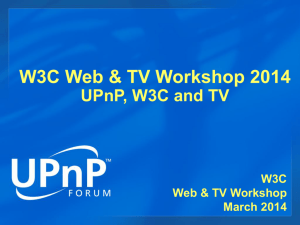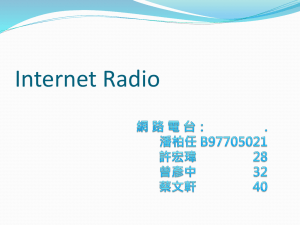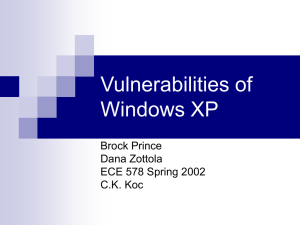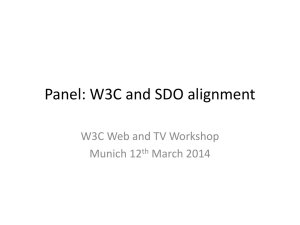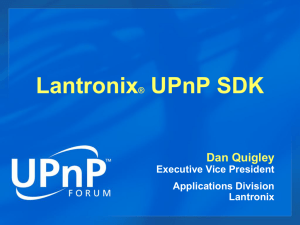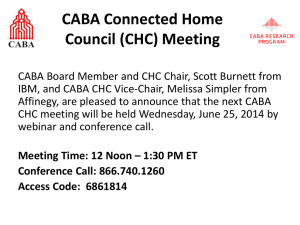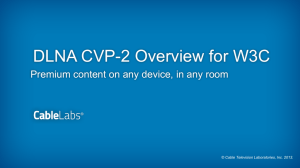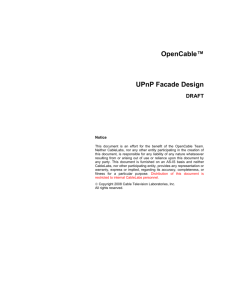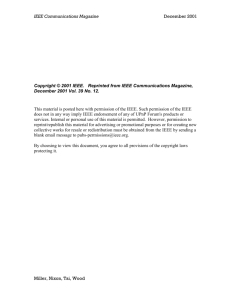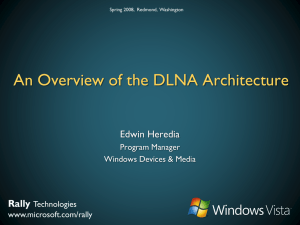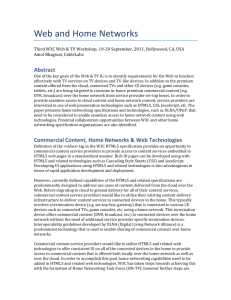YLC20120327
advertisement
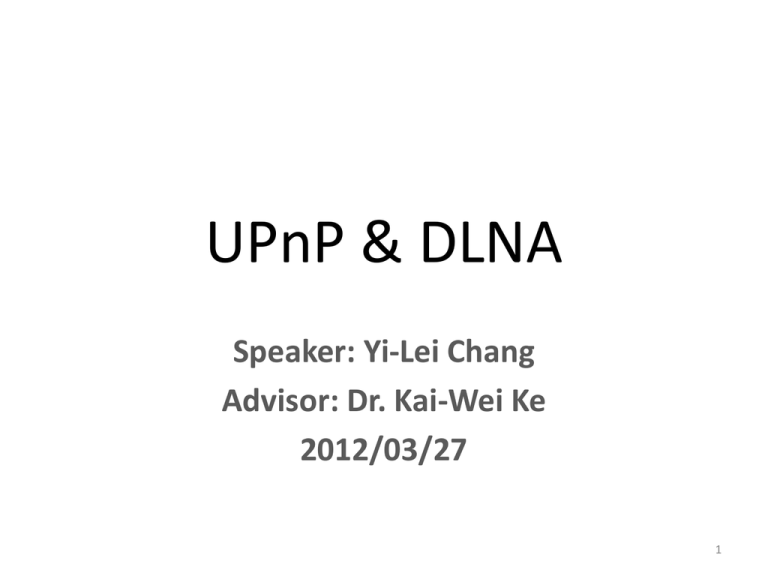
UPnP & DLNA Speaker: Yi-Lei Chang Advisor: Dr. Kai-Wei Ke 2012/03/27 1 Outline • • • • • Introduction UPnP DLNA Example - DLNA Family Intercom System Reference 2 Introduction • Networking is easy, except… –Network is unreliable –Programs need to talk to programs • But software is heterogeneous –Must upgrade system piece at a time 3 UPnP • UPnP Universal Plug-and-Play • Describe the protocols for communication between – Control point (CP) • Controllers – Device • Provide services – An actual device might contain both functions 4 UPnP - CP, Device & Service ? ? 5 UPnP - Protocol Stack 6 Steps to UPnP Networking • Addressing – CP and device get addresses • Discovery – CP finds interesting device • Description – CP learns about device capabilities • Control, Eventing and Presentation – CP invokes actions on device – CP listens to state changes of device – CP views device status using HTML UI 7 UPnP - Addressing • Use DHCP • If DHCP not work – Auto IP – Periodically try DHCP • UPnP Device Architecture 1.1 Support IPv6 8 UPnP - Discovery • Use SSDP (Simple Service Discovery Protocol) • Control points – Find interesting device/service – All/filter • Device – Advertise when added – Refresh advertisements – Cancel advertisements when removed – Response search request 9 Discovery - Protocol Stack 10 Discovery - Packet • Advertising – – – – – NOTIFY * HTTP/1.1 HOST: 239.255.255.250:1900 LOCATION: URL for UPnP description for root device NT: notification type NTS: ssdp:alive • Searching – – – – – M-SEARCH * HTTP/1.1 HOST: 239.255.255.250:1900 MAN: "ssdp:discover" MX: seconds to delay response ST: search target • Responding – HTTP/1.1 200 OK – LOCATION: URL for UPnP description for root device – ST: search target 11 Discovery - Sequence Diagram 12 UPnP - Description • Control point – learns about device capability – Use URI from discovery step to get device description – Use URI from device description to get service description • Device – Declare capability • • • • Type Physical Logical (Service) UI 13 Description - Protocol Stack 14 Description - Packet • Description request – GET /descriptionPath HTTP/1.1 – HOST: hostname:portNumber – ACCEPT-LANGUAGE: language preferred by control point • Description response – – – – HTTP/1.1 200 OK CONTENT-LANGUAGE: language used in description CONTENT-TYPE: text/xml; charset="utf-8" XML Description 15 Description - Device Description • <?xml version="1.0"?> • <root ns="urn:schemas-upnp-org:device-1-0" • configId="configuration number"> • …… • <device> • <deviceType>urn:schemas-upnp-org:device:deviceType:v</deviceType> • …… • <UDN>uuid:UUID</UDN> • …… • <serviceList> • <service> • <serviceType>urn:schemas-upnp-org:service:serviceType:v</serviceType> 16 Description - Device Description • <serviceId>urn:upnp-org:serviceId:serviceID/serviceId> • <SCPDURL>URL to service description</SCPDURL> • <controlURL>URL for control</controlURL> • <eventSubURL>URL for eventing</eventSubURL> • </service> • …… • </serviceList> • <deviceList> • …… • </deviceList> • <presentationURL>URL for presentation</presentationURL> • </device> • </root> 17 Description - Service Description • <?xml version="1.0"?> • <scpd • …… • <actionList> • <action> • <name>actionName</name> • <argumentList> • <argument> • <name>argumentNameIn1</name> • <direction>in</direction> • <relatedStateVariable>stateVariableName</relatedStateVariable> • </argument> 18 Description - Service Description • …… • </actionList> • <serviceStateTable> • <stateVariable sendEvents="yes"|"no" multicast="yes"|"no"> • <name>variableName</name> • <dataType>basic data type</dataType> • <defaultValue>default value</defaultValue> • …… • </stateVariable> • …… • <serviceStateTable> • </scpd> 19 Description - Sequence Diagram 20 UPnP - Control • Use SOAP Simple Object Access Protocol • Control point – Invokes actions on device – Use URI from description step to send actions to device • Device – Response action result 21 Control - Protocol Stack 22 Control - Packet • Action invocation – – – – POST path control URL HTTP/1.1 HOST: hostname:portNumber u:actionName xmlns:u="urn:schemas-upnp-org:service:serviceType:v argumentName in arg value • Action Response – HTTP/1.0 200 OK – u:actionNameResponse xmlns:u="urn:schemas-upnp-org:service:serviceType:v – argumentName out arg value • Action error response – – – – HTTP/1.1 500 Internal Server Error Faultstring UPnPError errorCode error code errorDescription error string 23 Control - Sequence Diagram 24 UPnP - Eventing • Use GENA General Event Notification Architecture • Control point – Use URI from description step to subscribe to events from device • Device – Notify 25 Eventing - Protocol Stack 26 Eventing - Packet • SUBSCRIBE with NT and CALLBACK – SUBSCRIBE publisher path HTTP/1.1 – CALLBACK: <delivery URL> – NT: upnp:event – TIMEOUT: Second-requested subscription duration • Response – HTTP/1.1 200 OK – SID: uuid:subscription-UUID – TIMEOUT: Second-actual subscription duration 27 Eventing - Packet • Event message – NOTIFY delivery path HTTP/1.1 – NT: upnp:event – NTS: upnp:propchange – SID: uuid:subscription-UUID – SEQ: event key – e:propertyset – e:property – variableName new value 28 Eventing - Sequence Diagram 29 UPnP - Presentation • Control point – views device status using HTML agent • Don not constrain implementation 30 Presentation - Protocol stack 31 DLNA • DLNA Digital Living Network Alliance • Goal: Establish an ecosystem of compatible products for networked media devices • Develops standards-based specifications – DLNA Guidelines 32 33 DLNA - Device Class Home Network Devices Mobile Handheld Device Digital Media Server Mobile Digital Media Server Digital Media Player Mobile Digital Media Player Digital Media Renderer Mobile Digital Media Downloader Digital Media Controller Mobile Digital Media Uploader Digital Media Printer Mobile Digital Media Controller Home Infrastructure Device Mobile Network Connectivity Function Mobile Interoperability Unit 34 DLNA - Media Format For Home Device Media Formats Required Formats Set Optional Formats Set Imaging JPEG GIF.TIFF.PNG Audio LPCM( 2 Channel) MP3.WMA9. AC-3.AAC.ATRAC3plus Video MPEG2 For Mobile/Handheld Devices Media Formats Required Formats Set Optional Formats Set Imaging JPEG GIF.TIFF.PNG Audio MP3 and MPEG4 AAC LC MPEG4 (HE AAC, AAC LTP, BSAC), AMR, ATRAC3plus, G.726, WMA, LPCM Video MPEG4 AVC (AAC LC Assoc Audio) VC1, H.263, MPEG4 part 2, MPEG2, MPEG4 AVC (BSAC or other for Assoc. Audio) 35 DLNA - Work Model 2-Box • Pull 36 DLNA - Work Model 2-Box • Push 37 DLNA - Work Model 3-Box 38 An example - DFIS • DFIS DLNA Family Intercom System • Traditional intercom system – Only allows place-to-place communication – Necessary to dial the extension number of a specific family member • DFIS – Support user mobility – Without the knowledge of the extension number that caters to a fixed location 39 DFIS - System Architecture • DFID DLNA Family Intercom Device – User profile management – DFIS device discovery 40 DFIS - System Architecture Cont. • DFIA DLNA Family Intercom Adapter – PSTN Device Management (DM) • Forward PSTN signal to UPnP DM (to convert PSTN devices to virtual DFIDs) • Dial PSTN through FXS – UPnP DM • Forward DFID list to SIP/PSTN DM (To convert DFIDs to virtual SIP/PSTN Device) • Create virtual DFIDs for SIP/PSTN devices – SIP DM • Forward SIP proxy registered message to UPnP DM (To convert SIP devices to DFIDs) • Create virtual SIP devices for DFIDs • UPnP2PSTN Bridge • UPnP2SIP bridge 41 DFIS - Simulation environment 42 The basic flows of a simple call process 43 The message flows in UPnP utilizes events 44 Reference [1] Contributing Members of the UPnP Forum, “UPnP™ Device Architecture 1.1,” October 15, 2008. Retrieved March 18, 2012 from World Wide Web: http://www.upnp.org/specs/arch/UPnP-archDeviceArchitecture-v1.1.pdf. [2] Contributing Members of the UPnP Forum, “UPnP™ Device Architecture 1.0,” April 24, 2008. Retrieved March 10, 2012 from World Wide Web: http://www.upnp.org/specs/arch/UPnP-archDeviceArchitecture-v1.0.pdf. [3] Digital Living Network Alliance, “How It Works,” 2012. Retrieved March 10, 2012 from World Wide Web: http://www.dlna.org/dlna-for-industry/digital-living/how-it-works. [4] Allegro Software Development Corporation, “Networked Digital Media Standards: A UPnP/DLNA Overview,” 2006. Retrieved March 12, 2012 from World Wide Web: http://www.allegrosoft.com/UPnP_DLNA_White_Paper.pdf [5] Chin-Feng Lai, Hsien-Chao Huang, Yueh-Min Huang and Han-Chieh Chao, “Design and Implementation of the DLNA Family Intercom System for Smart Homes,” Computer Journal, Vol. 52, No. 8, pp. 960-968. 45 Thanks for Listening Q&A 46
